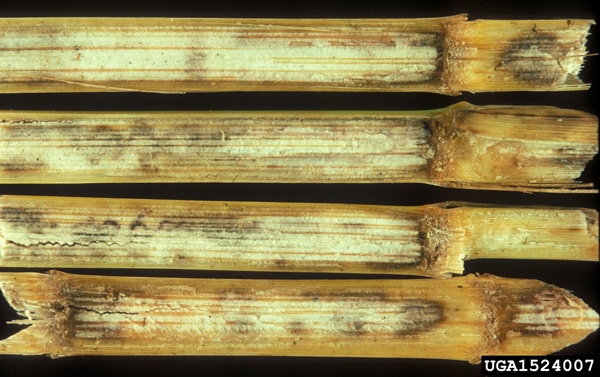August 22, 2012

The 2012 growing season, with mid-season conditions that favored kernel set followed by conditions that favored plant stress, was ideal for the development of stalk rots, says University of Illinois Extension Educator Angie Peltier. “Stalk rots increase lodging potential, which can decrease harvestable yield and leave much of it on the ground. Corn plants are top-heavy, and stalk rots increase the chances that plants will fall over, or lodge, due to gravity or wind and weather events,” she explains.
Many of the fungi that cause common stalk rots in Illinois survive in corn residue. Agricultural practices, such as continuously planting corn and conservation tillage, increase the amount of residue on the soil surface and the risk of stalk rot. Plants on high-nitrogen and low-potassium soils are at increased risk for the disease.
At the Northwestern Illinois Agricultural Research and Demonstration Center (NWIARDC) north of Monmouth, early planting, residual soil moisture and a 2-in. rain on June 30 resulted in successful pollination and the potential for large ears. After pollination, however, plants received only 0.09 in. of rain in July. This, along with temperatures that were more than 5° above normal, led to water- and heat-stressed plants.
Kernels place a very high demand on the plant for sugars. Stress slows photosynthesis, thereby reducing the amount of sugars that the plant is able to produce.
Many different stresses can reduce the rate of photosynthesis in the crop: too much or too little moisture; nutrient imbalances; plant injury (for example, from hail, insects, diseases); excessive plant populations; and even long periods of cloudy weather. If the plant is unable to keep up with kernel sugar demand, it may rob sugars from stalk tissue, predisposing it to stalk rots.
Symptoms of anthracnose stalk rot were observed at NWIARDC, both inside and outside the stalks. External symptoms included shiny, black discoloration of the rind.
External symptoms do not indicate what is happening inside the plant. Plants with rind symptoms do not necessarily have internal symptoms, and some plants without any external symptoms can be severely diseased inside. Internal symptoms include blackened and discolored tissue that can be easily crushed.
Stalks were rated on July 31 and on Aug. 14. Whereas there were no stalk rot symptoms on July 31, stalk rots were common on Aug. 14. Many stalks had just the beginning symptoms of stalk rot with discoloration at the outer margin of lower nodes. A few exhibited the more severe symptoms of shredded pith tissue.
If fields have stalk rot now, there is no way to get rid of it this year. There are, however, several things that can be done both to minimize the risk of stalk rots in future growing years and reduce the risk of leaving this year’s yields on the ground.
To minimize this year’s harvest losses, scouting for stalk rots is essential. Begin scouting just before physiological maturity (when a black layer forms between the kernel and cob), when grain moisture is between 30% and 40%. Scout each field either by pinching or pushing plants. Walk each field in a zig-zag pattern, checking 20 random plants from five spots in the field.
“For the pinch test, pinch stalks toward the bottom, below the lowest node, checking for firmness,” Peltier says. “For the push test, hold your arm up at a 45° angle from your body and push the plant to see if the stalk breaks.”
With either test, lodging potential is significant if 10-15% of the plants fail. Harvest the fields with the greatest lodging potential first. When harvesting lodged corn, drive slowly, and harvest against the grain.
To minimize future risk, look into purchasing seed with good stalk rot, lodging or standability ratings. Crop rotation and best management practices – such as balancing soil fertility, planting recommended populations and scouting and treating for insects and diseases that have reached economic thresholds – are important ways to reduce the risk of disease.
For more information, follow the Hill and Furrowblog, which highlights research at the NWIARDC and topics related to crop production in Western Illinois.
You May Also Like




